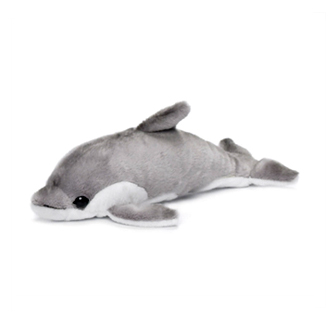“Inventors” of the sonar, amazing acrobats, keen swimmers devoted to love, dolphins are the most sociable inhabitants of the Greek seas.
The Greek sea enjoys the privilege of hosting four species of dolphins: the striped dolphin (Stenella coeruleoalba), the bottlenose dolphin (Tursiops truncatus), the Risso’s dolphin (Grampus griseus) and the short-beaked common dolphin (Delphinus delphis). All dolphins have an echolocation system which they use to orient themselves, to forage and to communicate. Their sociable, playful and romantic communication involves codes that are hard to imagine for a marine mammal.
However, though dolphins are so lovable, humans remain their only natural enemy. Oil pollution, contamination by synthetic chemical compounds accumulated in their tissues, climate change, disturbance, harassment by recreational vessels, noise pollution, military drills and the search for hydrocarbons threaten all dolphin species as well as all other marine mammals.
Can we learn to live together and share our home? Let’s find out!
STRIPED DOLPHINS

© Frédéric Bassemayouse
The Life of the Striped Dolphin
Did you know that the smallest dolphin species in the world lives in the Corinthian Gulf?
Striped dolphins (Stenella coeruleoalba) are not only the smallest of their family; they are also the ones we most frequently encounter in Greek waters. They are gray and get their name from the black stripe that begins from their eyes and goes down to their undersides. With an average length of 1.65 meters, they are smaller than the other dolphins. They live in almost every part of the Greek sea in great depth but close to shore. An isolated population lives in the enclosed Corinthian Gulf.
They are keen swimmers and usually swim at up to 35 km/h, though when in a hurry they can reach up to 60 km/h. They feed mainly on squid as well as small pelagic fish, such as anchovies. They reach adulthood at 11–12 years of age and give birth during summer months roughly every 3 years. Their maximum life expectancy is 45 years. All of the aforementioned attributes hardly bring to mind a threatened animal. Nevertheless, the striped dolphin is considered a vulnerable species according to The Red Data Book of Threatened Animals of Greece (Athens, 2009).
The Corinthian Gulf: A Unique Case
Two globally unique phenomena occur in the Corinthian Gulf, regarding the species of dolphins that reside there:
- The Corinthian is most likely the only area in the world where a striped dolphin population lives isolated in an enclosed gulf. Its waters go as deep as 930 meters. As a result, striped dolphins thrive there thanks to the great and abrupt depths, which create a closed pelagic ecosystem.
- In the Corinthian Gulf striped dolphins are found in mixed groups along with Risso’s and common dolphins.
Life under Threat
The threats that striped dolphins face are intentional killing, accidental entrapment during fishing activities and contamination by synthetic chemical compounds.
BOTTLENOSE DOLPHINS

© Jürgen Freund / WWF Canon
The Life of the Bottlenose Dolphin
An outstanding acrobat with jumps that go as high as 8 meters, the bottlenose dolphin (Tursiops truncatus) is the second most common dolphin species in Greek waters.
Bottlenose dolphins live in all coastal areas of the country and are the only cetaceans that live in the Amvrakikos Gulf. Though they are more than 3 meters long, they travel at over 30 km/h. They prefer to feed on fish that humans are also fond of, such as red mullets, sardines and cod fish, while not ignoring cuttlefish or octopuses.
Their maximum life expectancy is 55 years and they reach adulthood between the ages of 7 and 13.
Unfortunately, the bottlenose dolphin is also considered vulnerable according to The Red Data Book of Threatened Animals of Greece (Athens, 2009).
Life under Threat
The species faces threats related to fishing (accidental entrapment during fishing activities, intentional killing), the degradation of the ecosystem and the depletion of food resources.
RISSO’S DOLPHINS

© Frédéric Bassemayouse
The Life of the Risso’s dolphin
Risso’s dolphins (Grampus griseus) immediately stand out among the other dolphins because they have no snout and their bodies are covered with... scratches!
With a length of up to 3.30 meters, they are the largest dolphins of the Greek seas. They are born grey, but, as they get older, their bodies are gradually covered by the representative white scratches—a result of fighting with other individuals of the same species. They travel at up to 37 km/h and can dive down to 500 meters deep and remain underwater for up to 30 minutes. They feed mainly on squid and occasionally on fish. Gestation lasts 13–14 months. Their exact life span is unknown, but it exceeds 30 years (perhaps by far). Rarest than the others, Risso’s dolphins live mostly in the Myrtoan Sea, in Chalkidiki, in the northern Sporades Islands, in Kithira and in southwestern Crete. Mediterranean Risso’s dolphins have no contact with the ones of the western Atlantic Ocean.
Unfortunately, the Risso’s dolphin is considered an endangered species according to The Red Data Book of Threatened Animals of Greece (Athens, 2009).
Life under Threat
Risso’s dolphins are threatened by accidental entrapment during fishing activities as well as by the ingestion of solid waste.
COMMON DOLPHINS

© Erkki Siirilä / WWF Canon
The Life of the Common Dolphin
The common dolphin (Delphinus delphis) is unfortunately anything but common in the Greek seas, being threatened with extinction according to The Red Data Book of Threatened Animals of Greece (Athens, 2009).
The common dolphins’ colors are quite complex, a combination of grey, black, white and yellow, and quite different from those of the other dolphins. Their average length is 1.80 meters and they feed on fish such as anchovies and sardines, and, in the Corinthian Gulf, probably on squid.
We do not know the exact number of common dolphins swimming in Greek waters, but we do know that their population has been gravely reduced during the past 30–40 years. Under normal circumstances, they give birth to one calf every 2–3 years and gestation lasts 10–11 months. Their maximum life span is unknown. They can be found in areas up to 200 meters deep and near the coast in the northern Ionian Sea, the Corinthian and the Saronikos Gulfs, in the island complexes Dodekanisa and Cyclades, in the northern Euboean, the Pagasitikos and the Thermaikos Gulfs. The Thracian Sea is also of great importance to the species. In the Corinthian Gulf, common dolphins, striped dolphins and Rossi’s dolphins live together in mixed communities—a phenomenon that is not observed anywhere else in the world.
Life under Threat
Common dolphins are threatened by the depletion of available food resources, fishing activities (intentional killing or accidental entrapment) as well as contamination by synthetic chemical compounds.
Τhe European project “Thalassa Campaign: Learn, Act, Protect/Awareness, Educational and Participation Campaign for Marine Mammals in Greece” was implemented by MOm/The Hellenic Society for the Study and Protection of the Mediterranean Monk Seal and WWF Greece together with Cetacean Research Institute Pelagos and Tethys Research Institute, with the contribution of LIFE financial instrument of the European Union, the Stavros Niarchos Foundation, Blue Planet Shipping SA and the Green Fund.
Share this







